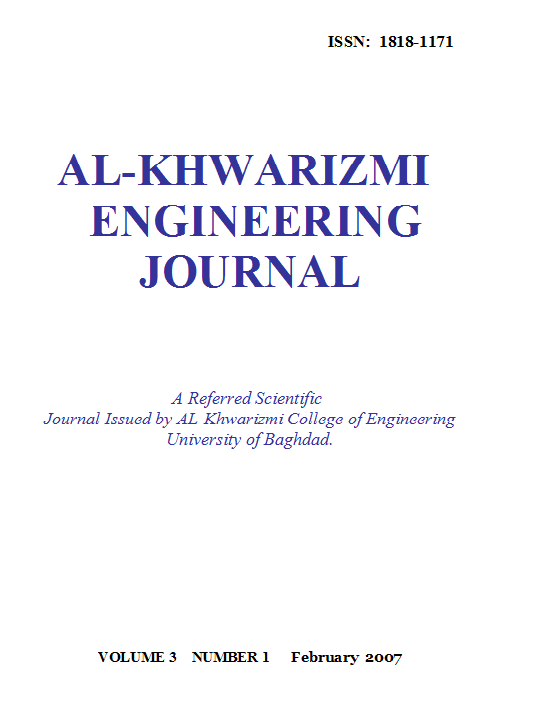Image restoration using regularized inverse filtering and adaptive threshold wavelet denoising
Abstract
Although the Wiener filtering is the optimal tradeoff of inverse filtering and noise smoothing, in the case when the blurring filter is singular, the Wiener filtering actually amplify the noise. This suggests that a denoising step is needed to remove the amplified noise .Wavelet-based denoising scheme provides a natural technique for this purpose .
In this paper a new image restoration scheme is proposed, the scheme contains two separate steps : Fourier-domain inverse filtering and wavelet-domain image denoising. The first stage is Wiener filtering of the input image , the filtered image is inputted to adaptive threshold wavelet denoising stage . The choice of the threshold estimation is carried out by analyzing the statistical parameters of the wavelet sub band coefficients like standard deviation, arithmetic mean and geometrical mean . The noisy image is first decomposed into many levels to obtain different frequency bands. Then soft thresholding method is used to remove the noisy coefficients, by fixing the optimum thresholding value by this method .
Experimental results on test image by using this method show that this method yields significantly superior image quality and better Peak Signal to Noise Ratio (PSNR). Here, to prove the efficiency of this method in image restoration , we have compared this with various restoration methods like Wiener filter alone and inverse filter.
Downloads
References
[2] Scott E Umbang., "Computer Vision and Image Processing", A Practical Approach Using CVIP Tools, Prentice Hall, Inc., Upper Saddle River, 1998.
[3] Lakhwinder Kaur , Savita Gupta , R.C. Chauhan , "Image Denoising using Wavelet Thresholding", Dept. of CSE SLIET, Longowal Punjab (148106), India, E-mail:
[email protected], savita2k8,@yahoo.com, [email protected]
[4] D.Gnanadurai, and V.Sadasivam, “An Efficient Adaptive Thresholding Technique for Wavelet Based Image Denoising", International Journal of Signal Processing Volume 2 Number 2 2005 ISSN 1304-4494.
[5] Zeljko Devcic Sven Loncaric “Blur Identification Using Averaged Spectra of Degraded Image Singular Vectors “, Institute for Defence Studies, Research and Development, University of Zagreb, Bijenicka 46, 10000 Zagreb, Croatia,
E-mail: [email protected]
[6] Byung-Jun Yoon and P. P. Vaidyanathan, " Wavelet-Based Denoising by Customized Thresholding", Dept. of Electrical Engineering California Institute of Technology, Pasadena, CA 91125, USA,
E-mail:
[email protected], [email protected]
[7] Xiaoyan Xu, “Image Denoising in Wavelet Domain”, School of Engineering, University of Guelph,
E-mail: xux@uoguelph.
[8] Carl Taswell , " Experiments in Wavelet Shrinkage Denoising " C. Taswell ([email protected]) , Computational Toolsmiths , POB 18925, Stanford, CA 94309-8925.
[9] Yi Wan and Robert D. Nowak ," Wavelet-Based Statistical Model For Image Restoration " , Rice University , Department of Electrical Engineering, 6100 South Main Street, Houston, TX 77005, USA.
[10] Javier Portilla and Eero P. Simoncelli ," Image Denoising Via Adjustment of Wavelete Coefficient Magnitude Correlation", Center for Neural Science, and Courant Institute of Mathematical Sciences New York University, NY 10003,
E-mail: fjavier,[email protected].
[11] Jae S. Lim, " Image Restoration by Short Space Spectral Subtraction”, IEEE Transactions on Acoustics, Speech, and Signal Processing, Vol. ASSP-28, No. 2, April, 1980.
[12] A. Buades, B. Coll, And J. M. Morel, “A review of Image Denoising Algorithms with a New One”, Multiscale Model. Simul. 2005 Society for Industrial and Applied Mathematics, Vol. 4, No. 2, pp. 490–530.
[13] MATLAB Help, Version 7.
Downloads
Published
Issue
Section
License
Copyright: Open Access authors retain the copyrights of their papers, and all open access articles are distributed under the terms of the Creative Commons Attribution License, which permits unrestricted use, distribution, and reproduction in any medium, provided that the original work is properly cited. The use of general descriptive names, trade names, trademarks, and so forth in this publication, even if not specifically identified, does not imply that these names are not protected by the relevant laws and regulations. While the advice and information in this journal are believed to be true and accurate on the date of its going to press, neither the authors, the editors, nor the publisher can accept any legal responsibility for any errors or omissions that may be made. The publisher makes no warranty, express or implied, with respect to the material contained herein.












